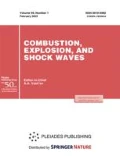Abstract
The compression of ceramic (corundum) tubes by the detonation products of explosives have been studied experimentally and numerically. The formation of the shaped-charge jet of ceramic particles and its effect on steel witnesses targets has been investigated. The tubes were produced by detonation spraying. Ceramic particles were deposited on copper tubes, which were then dissolved in a solution of ferric chloride. In the experiments, a considerable penetration of the flow of ceramic particles was observed. During the interaction of the flow with the target, the target material was partially evaporated, as shown by metallographic analysis. Numerical analysis of the formation of the discrete shaped-charge jet showed that the maximum velocity of the jet head was about 23 km/s, and the velocity of the main part of the jet was about 14 km/s.
Similar content being viewed by others
References
W. S. Koski, F. A. Lucy, R. G. Shreffler, and E. J. Willig, “Fast Jets from Collapsing Cylinders,” J. Appl. Phys. 23, 1300–1305 (1952).
S. A. Kinelovskii and Yu. A. Trishin, “Physical Aspects of the Hollow-Charge Effect,” Fiz. Goreniya Vzryva 16 (5), 26–40 (1980) [Combust., Expl., ShockWaves 16 (5), 504–515 (1980)].
W. P. Walters and J. A. Zukas, Fundamentals of Shaped Charges (Willey, 1989).
V. M. Titov, Yu. I. Fadeenko, and N. S. Titova, “Acceleration of Solid Particles by Cumulative Explosion,” Dokl. Akad. Nauk SSSR 180 (5), 1051–1052 (1968).
R. Shell, “Detonation Physics,” in High-Speed Physics, Part 2 (1967), pp. 276–349.
Yu. A. Trishin, “Some Physical Problems of Cumulation,” Prikl. Mekh. Tekh. Fiz. 41 (5), 10–26 (2000) [J. Appl. Mech. Tech. Phys. 41 (5), 773–787 (2000)].
Yu. A. Trishin, Physics of Shaped-Charge Processes (Lavrent’ev Institute of Hydrodynamics, Siberian Branch, Russian Acad. of Sci., Novosibirsk, 2005) [in Russian].
I. A. Balagansky, V. A. Agureikin, I. F. Kobilkin, N. I. Nosenko, V. V. Naumov, A. V. Vinogradov, and A. I. Balagansky, “Acceleration Device Based on High Explosive Charge which Contains High Modular Ceramic Tube,” Int. J. Impact Eng. 22, 813–823 (1999).
I. A. Balaganskii, A. V. Vinogradov, V. A. Agureikin, I. F. Kobylkin, and I. I. Nosenko, “Explosive Systems Based on Explosive Charges Comprising Tubes of High-Modulus Ceramic,” in Extreme States of Matter. Detonation. Shock Waves, Proc. III Khariton’s Scientific Readings (Sarov, 2002), pp. 289–294.
A. Shtertser, V. Ulianitsky, S. Zlobin, C. Muders, Jang Xi, and S. Veselov, “Computer Controlled Detonation Spraying of WC/Co Liners Containing MoS2 Solid Lubricant,” Surf. Liners Technol. 206, 4763–4770 (2012).
V. Ulianitsky, A. Shtertser, V. Sadykov, and I. Smurov, “Development of Catalytic Converters Using Detonation Spraying,” Mater. Manuf. Processes 31 (11), 1433–1438 (2016).
ANSYS Explicit Dynamics Analysis Guide (ANSYS, Inc. Release Southpointe, 2016).
R. F. Trunin, L. F. Gudarenko, M. V. Zhernokletov, and G. V. Simakov, Experimental Data on Shock Compression and Adiabatic Expansion of Condensed Matter (RFNC-VNIIEF, Sarov, 2001).
Author information
Authors and Affiliations
Corresponding author
Additional information
Original Russian Text © I.A. Balaganskii, L.A. Merzhievskii, V.Yu. Ul’yanitskii, I.A. Bataev, A.A. Bataev, A.D. Matrosov, I.A. Stadnichenko, I.S. Batraev, A.V. Vinogradov.
Rights and permissions
About this article
Cite this article
Balaganskii, I.A., Merzhievskii, L.A., Ul’yanitskii, V.Y. et al. Generation of Hypervelocity Particle Flows by Explosive Compression of Ceramic Tubes. Combust Explos Shock Waves 54, 119–124 (2018). https://doi.org/10.1134/S0010508218010173
Received:
Revised:
Published:
Issue Date:
DOI: https://doi.org/10.1134/S0010508218010173




